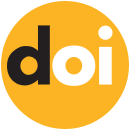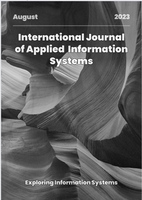The week's pick
Reseach Article
A Study on the Accessibility of Technology for Users with Disabilities
| International Journal of Applied Information Systems |
| Foundation of Computer Science (FCS), NY, USA |
| Volume 12 - Number 46 |
| Year of Publication: 2025 |
| Authors: Shrina Tyarla |
 10.5120/ijais2025452001
10.5120/ijais2025452001
|
Shrina Tyarla . A Study on the Accessibility of Technology for Users with Disabilities. International Journal of Applied Information Systems. 12, 46 ( Feb 2025), 33-38. DOI=10.5120/ijais2025452001
Abstract
The accessibility of technology for people with disabilities is a critical topic that addresses the need for inclusive design and the development of assistive technologies. As society increasingly relies on digital platforms, ensuring that individuals with disabilities can access and utilize these technologies is essential for promoting digital equity. Approximately 466 million people worldwide have hearing loss, and this number is expected to rise to 900 million by 2050. This paper illustrates the need for more inclusive technologies as well as designing digital content and experiences that are accessible to users with diverse abilities. By doing so, we can create a more inclusive and equitable digital landscape that empowers individuals with disabilities to fully participate in the online world.
References
- Vollenwyder, Beat, et al. "How compliance with web accessibility standards shapes the experiences of users with and without disabilities." International Journal of Human-Computer Studies 170 (2023): 102956.
- Sardella, Nayara, and Manuela Quaresma. "What is the value of using a non-accessible service for users with disabilities?." Service Design and Innovation Conference. 2023.
- Alsaeedi, Abdullah. "Comparing web accessibility evaluation tools and evaluating the accessibility of webpages: proposed frameworks." Information 11.1 (2020): 40.
- Krishnan, Reshmy, and Sivakumar Manickam. "Enhancing Accessibility: Exploring the Impact of AI in Assistive Technologies for Disabled Persons." Nafath 9.25 (2024).
- Layachi, Aida, and Nicola J. Pitchford. "Formative Evaluation of an Interactive Personalised Learning Technology to Inform Equitable Access and Inclusive Education for Children with Special Educational Needs and Disabilities." Technology, Knowledge and Learning (2024): 1-25.
- Kosch, Thomas, et al. "A survey on measuring cognitive workload in human-computer interaction." ACM Computing Surveys 55.13s (2023): 1-39.
- Benham, Sara, et al. "Mobile device accessibility with 3D printed devices for individuals with physical disabilities." Disability and Rehabilitation: Assistive Technology 19.6 (2024): 2279-2284.
- Santórum, Marco, et al. "An accessible serious game-based platform for process learning of people with intellectual disabilities." Applied Sciences 13.13 (2023): 7748.
- Zhou, Zhixuan, et al. "Iterative design of an accessible crypto wallet for blind users." Nineteenth Symposium on Usable Privacy and Security (SOUPS 2023). 2023.
- Kiambati, Fridah Gatwiri, Samuel Wanyonyi Juma, and Brenda Aromu Wawire. "Accessibility of digital systems in information retrieval by users with visual impairment." Quality Assurance in Education (2024).
- Luna Lorente, Belén, et al. "Assistive Technologies for Children with Physical Disabilities: a Systematic Literature Review." Proceedings of the XXIV International Conference on Human Computer Interaction. 2024.
- Liffick, B. W. (2003). Assistive technology as an HCI topic. Journal of computing sciences in colleges, 19(2), 142-144.
- Adithya Bikkani 2020, AEL Data Services website, accessed 24th August 2024,
- InfoStride Tech Hub 2024, InfoStride Technologies Website, accessed 24th August 2024,
- Shawn Lawton Henry 2024, W3C Web Accessibility initiative, World Wide Web Consortium (W3C®), accessed 24th August 2024,
- Kris Rivenburgh 2024, Accessible.org, LLC, accessed 24th August 2024,
- Guissoni, Ellen Diana Silva de Carvalho, André Pimenta Freire, and Rafael Dias Araújo. "Accessibility in Enterprise Resource Planning systems: Who is Responsible For It and What Are the Main Difficulties to Put It Into Practice?." Proceedings of the XVIII Brazilian Symposium on Information Systems. 2022.
- Prof. Catherine Holloway (Academic Director, GDI Hub), Prof. John Shawe-Taylor (IRCAI Director), Ana Rita Pinho 2022, UCL Department of Science, Technology, Engineering and Public Policy Website, University of Cambridge London, accessed 26th August 2024,
- Azevedo Coste, C., & Leporini, B. (2022). Introduction to the special theme Assistive technologies for a more accessible and inclusive society. ERCIM NEWS, 130, 6-7.
- Sankat, S., & Torkildsby, A. B. (2018). Achieving Success of “Accessible India Campaign” Through Universal Design Education in India. In Transforming Our World Through Design, Diversity and Education (pp. 40-55). IOS Press.
- Creed, C., Al-Kalbani, M., Theil, A., Sarcar, S., & Williams, I. (2024). Inclusive AR/VR: accessibility barriers for immersive technologies. Universal Access in the Information Society, 23(1), 59-73.
- Haque, M. A., Haque, S., Zeba, S., Kumar, K., Ahmad, S., Rahman, M., ... & Ahmed, L. (2024). Sustainable and efficient E-learning internet of things system through blockchain technology. E-Learning and Digital Media, 21(3), 216-235.
- Rashmi, R., & Mohanty, S. K. (2024). Socioeconomic and geographic variations of disabilities in India: evidence from the National Family Health Survey, 2019–21. International Journal of Health Geographics, 23(1), 4.
- Jain, S., & Jain, M. (2024). Revisiting the Conceptual Terrains of the Right to Accessibility in India: The Role of Judicial Enforcement. Laws, 13(4), 54.
- Ministry of Social Justice and Empowerment (2021), ACCESSIBLE INDIA CAMPAIGN AN INCLUSIVE SOCIETY CREATES A SASHAKT BHARAT, Press Information Bureau.
- Ministry of Health and Family Welfare (2022), National Family Health Survey 2019-2021 Issue , International Institute for Population Science.
Index Terms
Keywords

